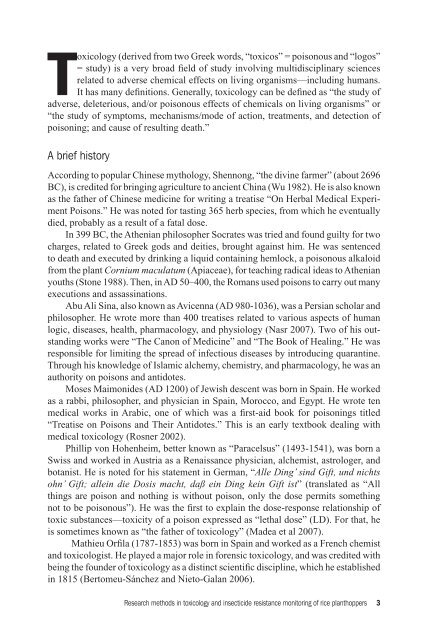Research Methods in Toxicology and Insecticide Resistance ...
Research Methods in Toxicology and Insecticide Resistance ...
Research Methods in Toxicology and Insecticide Resistance ...
You also want an ePaper? Increase the reach of your titles
YUMPU automatically turns print PDFs into web optimized ePapers that Google loves.
<strong>Toxicology</strong> (derived from two Greek words, “toxicos” = poisonous <strong>and</strong> “logos”<br />
= study) is a very broad fi eld of study <strong>in</strong>volv<strong>in</strong>g multidiscipl<strong>in</strong>ary sciences<br />
related to adverse chemical effects on liv<strong>in</strong>g organisms—<strong>in</strong>clud<strong>in</strong>g humans.<br />
It has many defi nitions. Generally, toxicology can be defi ned as “the study of<br />
adverse, deleterious, <strong>and</strong>/or poisonous effects of chemicals on liv<strong>in</strong>g organisms” or<br />
“the study of symptoms, mechanisms/mode of action, treatments, <strong>and</strong> detection of<br />
poison<strong>in</strong>g; <strong>and</strong> cause of result<strong>in</strong>g death.”<br />
A brief history<br />
Accord<strong>in</strong>g to popular Ch<strong>in</strong>ese mythology, Shennong, “the div<strong>in</strong>e farmer” (about 2696<br />
BC), is credited for br<strong>in</strong>g<strong>in</strong>g agriculture to ancient Ch<strong>in</strong>a (Wu 1982). He is also known<br />
as the father of Ch<strong>in</strong>ese medic<strong>in</strong>e for writ<strong>in</strong>g a treatise “On Herbal Medical Experiment<br />
Poisons.” He was noted for tast<strong>in</strong>g 365 herb species, from which he eventually<br />
died, probably as a result of a fatal dose.<br />
In 399 BC, the Athenian philosopher Socrates was tried <strong>and</strong> found guilty for two<br />
charges, related to Greek gods <strong>and</strong> deities, brought aga<strong>in</strong>st him. He was sentenced<br />
to death <strong>and</strong> executed by dr<strong>in</strong>k<strong>in</strong>g a liquid conta<strong>in</strong><strong>in</strong>g hemlock, a poisonous alkaloid<br />
from the plant Cornium maculatum (Apiaceae), for teach<strong>in</strong>g radical ideas to Athenian<br />
youths (Stone 1988). Then, <strong>in</strong> AD 50–400, the Romans used poisons to carry out many<br />
executions <strong>and</strong> assass<strong>in</strong>ations.<br />
Abu Ali S<strong>in</strong>a, also known as Avicenna (AD 980-1036), was a Persian scholar <strong>and</strong><br />
philosopher. He wrote more than 400 treatises related to various aspects of human<br />
logic, diseases, health, pharmacology, <strong>and</strong> physiology (Nasr 2007). Two of his outst<strong>and</strong><strong>in</strong>g<br />
works were “The Canon of Medic<strong>in</strong>e” <strong>and</strong> “The Book of Heal<strong>in</strong>g.” He was<br />
responsible for limit<strong>in</strong>g the spread of <strong>in</strong>fectious diseases by <strong>in</strong>troduc<strong>in</strong>g quarant<strong>in</strong>e.<br />
Through his knowledge of Islamic alchemy, chemistry, <strong>and</strong> pharmacology, he was an<br />
authority on poisons <strong>and</strong> antidotes.<br />
Moses Maimonides (AD 1200) of Jewish descent was born <strong>in</strong> Spa<strong>in</strong>. He worked<br />
as a rabbi, philosopher, <strong>and</strong> physician <strong>in</strong> Spa<strong>in</strong>, Morocco, <strong>and</strong> Egypt. He wrote ten<br />
medical works <strong>in</strong> Arabic, one of which was a fi rst-aid book for poison<strong>in</strong>gs titled<br />
“Treatise on Poisons <strong>and</strong> Their Antidotes.” This is an early textbook deal<strong>in</strong>g with<br />
medical toxicology (Rosner 2002).<br />
Phillip von Hohenheim, better known as “Paracelsus” (1493-1541), was born a<br />
Swiss <strong>and</strong> worked <strong>in</strong> Austria as a Renaissance physician, alchemist, astrologer, <strong>and</strong><br />
botanist. He is noted for his statement <strong>in</strong> German, “Alle D<strong>in</strong>g’ s<strong>in</strong>d Gift, und nichts<br />
ohn’ Gift; alle<strong>in</strong> die Dosis macht, daß e<strong>in</strong> D<strong>in</strong>g ke<strong>in</strong> Gift ist” (translated as “All<br />
th<strong>in</strong>gs are poison <strong>and</strong> noth<strong>in</strong>g is without poison, only the dose permits someth<strong>in</strong>g<br />
not to be poisonous”). He was the fi rst to expla<strong>in</strong> the dose-response relationship of<br />
toxic substances—toxicity of a poison expressed as “lethal dose” (LD). For that, he<br />
is sometimes known as “the father of toxicology” (Madea et al 2007).<br />
Mathieu Orfi la (1787-1853) was born <strong>in</strong> Spa<strong>in</strong> <strong>and</strong> worked as a French chemist<br />
<strong>and</strong> toxicologist. He played a major role <strong>in</strong> forensic toxicology, <strong>and</strong> was credited with<br />
be<strong>in</strong>g the founder of toxicology as a dist<strong>in</strong>ct scientifi c discipl<strong>in</strong>e, which he established<br />
<strong>in</strong> 1815 (Bertomeu-Sánchez <strong>and</strong> Nieto-Galan 2006).<br />
<strong>Research</strong> methods <strong>in</strong> toxicology <strong>and</strong> <strong>in</strong>secticide resistance monitor<strong>in</strong>g of rice planthoppers 3

















